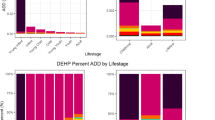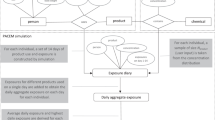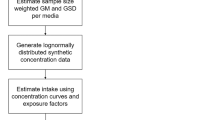Abstract
This paper presents a probabilistic, multimedia, multipathway exposure model and assessment for chlorpyrifos developed as part of the National Human Exposure Assessment Survey (NHEXAS). The model was constructed using available information prior to completion of the NHEXAS study. It simulates the distribution of daily aggregate and pathway-specific chlorpyrifos absorbed dose in the general population of the State of Arizona (AZ) and in children aged 3–12 years residing in Minneapolis–St. Paul, Minnesota (MSP). Pathways included were inhalation of indoor and outdoor air, dietary ingestion, non-dietary ingestion of dust and soil, and dermal contact with dust and soil. Probability distributions for model input parameters were derived from the available literature, and input values were chosen to represent chlorpyrifos concentrations and demographics in AZ and MSP to the extent possible. When the NHEXAS AZ and MSP data become available, they can be compared to the distributions derived in this and other prototype modeling assessments to test the adequacy of this pre-NHEXAS model assessment. Although pathway-specific absorbed dose estimates differed between AZ and MSP due to differences in model inputs between simulated adults and children, the aggregate model results and general findings for simulated AZ and MSP populations were similar. The major route of chlorpyrifos intake was food ingestion, followed by indoor air inhalation. Two-stage Monte Carlo simulation was used to derive estimates of both inter-individual variability and uncertainty in the estimated distributions. The variability in the model results reflects the difference in activity patterns, exposure factors, and concentrations contacted by individuals during their daily activities. Based on the coefficient of variation, indoor air inhalation and dust ingestion were most variable relative to the mean, primarily because of variability in concentrations due to use or no-use of pesticides. Uncertainty analyses indicated a factor of 10–30 for uncertainty of model predictions of 10th, 50th, and 90th percentiles. The greatest source of uncertainty in the model stems from the definition of no household pesticide use as no use in the past year. Because chlorpyrifos persists in the residential environment for longer than a year, the modeled estimates are likely to be low. More information on pesticide usage and environmental concentrations measured at different post-application times is needed to refine and evaluate this and other pesticide exposure models.
This is a preview of subscription content, access via your institution
Access options
Subscribe to this journal
Receive 6 print issues and online access
$259.00 per year
only $43.17 per issue
Buy this article
- Purchase on Springer Link
- Instant access to full article PDF
Prices may be subject to local taxes which are calculated during checkout


Similar content being viewed by others
References
Ahadaya SM Monroe RJ and Guthrie FE, Absorption and distribution of intubated insecticides in fasted mice. Pestic Biochem Physiol (1981) 16(1): 38–46
Atkinson R, A structural–activity relationship for the estimation of rate constants for the gas-phase reactions of OH radicals with organic compounds. Int J Chem Kinet (1987) 19: 799–828
Bakke JE Feil VJ and Price CE, Rat urinary metabolites from O,O-diethyl-O(3,5,6-trichloro-2-pyridyl) phosphorothioate. J Environ Sci Health Bull (1976) 3: 223–225
Bogen KT and Spear RC, Integrating uncertainty and inter-individual variability in environmental risk assessment. Risk Anal (1987) 7(4): 427–436
Boyd E, The Growth of the Surface Area of the Human Body University of Minnesota Press, Minneapolis, MN 1935
Brainard J, and Burmaster D, Bivariate distribution for height and weight of men and women in the United States. Risk Anal (1992) 12(2): 267–275
Burmaster DE Lloyd KJ and Crouch EAC, Lognormal distributions of body weight as a function of age for males and females in the United States, 1976–1980. Risk Anal (1997) 17(4): 499–505
Calabrese EJ Barnes R Stanek EJ Pastides H Gilbert CE Venman P Wang X Lasztity A and Kostecki PT, How much soil do young children ingest: an epidemiologic study. Regul Toxicol Pharmacol (1989) 10: 123–137
Calabrese EJ Stanek EJ Gilbert CE and Barnes RM, Preliminary adult soil ingestion estimates: results of a pilot study. Regul Toxicol Pharmacol (1990) 12: 88–95
Camann DE and Buckley JD, Carpet dust: an indicator of exposure at home to pesticides, PAHs, and tobacco smoke. Abstract 141, ISEE/ISEA Joint Annual Conference, Research Triangle Park, NC, September (1994)
CARB, Study of children's activity patterns. Final Report, Contract No. A733-149, Sacramento, California (1991)
CARB, Measurement of breathing rate and volume in routinely performed daily activities. Final Report. Contract No. A033-205, Sacramento, California (1993)
Carey AE and Kutz FW, Trends in ambient concentrations of agrochemicals in humans and the environment of the USA. Environ Monit Assess (1985) 5(2): 155–164
Colditz GA, The Nurses' Health Study: findings during 10 years of follow-up of a cohort of U.S. women. Curr Probl Obstet, Gynecol Fertil (1990) 13(4): 131–174
Davis S, Waller P, Buschom R, Ballou J, and White P, Quantitative estimates of soil ingestion in normal children between the ages of 2 and 7 years: population-based estimates using aluminum, silicon, and titanium as soil tracer elements. Arch Environ Health (1990) 45(2): 112–122
Duff RM and Kissel JC, Effect of soil loading on dermal absorption efficiency from contaminated soils. J Toxicol Environ Health (1996) 48(6): 93–106
Fenske RA Black KG Elkner KP Lee CL Methner MM and Soto R, Potential exposure and health risks of infants following indoor residential pesticide applications. Am J Public Health (1990) 80(6): 689–693
Fontaine DD and Teeter D, Photodegradation of chlorpyrifos in the vapor phase. Rep. GH-C 1911 Dow Chemical USA, Midland, MI, 1987
Frey HC, Quantitative Analysis of Uncertainty and Variability in Environmental Policy Making American Association for the Advancement of Science, Washington, DC, September 1992
Gehan E, and George GL, Estimation of human body surface area from height and weight. Cancer Chemother. Rep. (1970) 54(4): 225–235
Hawley J, Assessment of health risk from contaminated soils. Risk Anal. (1985) 5: 289–302
HSPH (Harvard University School of Public Health), NHEXAS pilot exposure assessment study: estimated lead exposure in U.S. EPA Region V and Arizona. Draft Report (1997)
IAEA, Evaluating the Reliability of Predictions Made Using Environmental Transfer Models, Safety Series No. 100 International Atomic Energy Agency, Vienna, (1989)
Iman RL and Helton JC, An investigation of uncertainty and sensitivity analysis techniques for computer models. Risk Anal (1988) 8(1): 71–90
Kimbrough RD Falk H Stehr P and Fries G, Health implications of 2,3,7,8-TCDD contamination of residual soil. J Toxicol Environ Health (1984) 14: 47–93
Lebowitz MD O'Rourke MK Gordon S Moschandreas DJ Buckley T and Nishioka M, Population-based exposure measurements in Arizona: a Phase I field study in support of the National Human Exposure Assessment Survey. J Expos Anal Environ Epidemiol (1995) 5: 297–326
Lewis RG Fortmann RC and Camann DE, Evaluation of methods for monitoring the potential exposure of small children to pesticides in the residential environment. Arch Environ Contam Toxicol (1994) 26(3): 37–46
MacIntosh DL Xue J and Özkaynak H, NHEXAS pre-field exposure assessment study: estimated benzene exposures and absorbed doses in U.S. EPA Region V and Arizona, Final Report (1995a)
MacIntosh DL Xue J Özkaynak H Spengler JD and Ryan PB, A population-based exposure model for benzene. J Expos Anal Environ Epidemiol (1995b) 5(3): 375–404
MacIntosh DL Spengler JD Özkaynak H Tsai L-H and Ryan PB, Dietary exposures to selected metals and pesticides. Environ Health Perspect (1996) 104(2): 202–209
Morgan MG and Henrion M, Uncertainty: A Guide to Dealing with Uncertainty in Quantitative Risk and Policy Analysis Cambridge University Press, New York, NY, 1990
NCHS, Anthropometric Reference Data and Prevalence of Overweight, United States, 1976–1980. Data from the National Health Survey National Center for Health Statistics, U.S. HHS, Hyattsville, MD, 1987
Nolan RJ Rick DL Freshour NL and Saunders JH, Chlorpyrifos: pharmacokinetics in human volunteers. Toxicol Appl Pharmacol (1984) 73(1): 8–15
NRC (National Research Council) Pesticides in the Diets of Infants and Children National Academy Press, Washington, DC, 1993
NRC (National Research Council.) Science and Judgement in Risk Assessment National Academy Press, Washington, DC, 1994
Ott WR, A physical explanation of the lognormality of pollutant concentrations. J Air Waste Manage Assoc (1990) 40: 1378–1383
Pellizzari E, Lioy P, Quackenboss J, Whitmore R, Clayton A, Freeman N, Waldman J, Thomas K, Rodes C, and Wilcosky T, Population-based exposure measurements in EPA region 5: a Phase I field study in support of the National Human Exposure Assessment Survey. J Expos Anal Environ Epidemiol (1995) 5(3): 327–358
Pennington J, and Gunderson EL, History of the Food and Drug Administration's total diet study — 1961 to 1987. J AOAC Int (1987) 70(5): 772–782
Phillips LJ Fares RJ, and Schweer LG, Distributions of total skin surface area to body weight ratios for use in dermal exposure assessments. J Expos Anal Environ Epidemiol (1993) 3(3): 331–338
Rimm EB Stampfer MJ Ascherio A Giovannucci EL Colditz GA and Willett WC, Vitamin E consumption and the risk of coronary heart disease in men. N Engl J Med (1993) 328: 1450–1456
Robinson JP and Thomas J, Time Spent in Activities, Locations, and Microenvironments: A California–National Comparison Environmental Monitoring Systems Laboratory, U.S. EPA, Las Vegas, NV, 1991
Simcox NJ Fenske RA Wolz SA Lee IC and Kalman DA, Pesticides in household dust and soil: exposure pathways for children of agricultural families. Environ Health Perspect (1995) 103(12): 1126–1134
Smith GN Watson BS and Fischer FS, Investigations on dursban insecticide. Metabolism of (36Cl) O,O-diethyl-O-3,5,6-trichloro-2-pyridyl phosphorothioate in rats. J Agric Food Chem (1967) 15: 132–138
Stanek EJ and Calabrese EJ, Soil ingestion in children: outdoor soil or indoor dust?. J Soil Contam (1992) 1(1): 1–28
Taylor A, Using objective and subjective information to develop distributions for probabilistic exposure assessment. J Expos Anal Environ Epidemiol (1993) 3(3): 285–298
Thompson KM and Burmaster DE, Parametric distribution for soil ingestion by children. Risk Anal (1991) 2: 339–342
UMO, On-line 1990 US census data University of Missouri, 1994
U.S. EPA, Pesticides in Groundwater Database: A Compilation of Monitoring Studies 1971–1991, Region IX. EPA 734-12-92-001 Office of Pesticides and Toxic Substances, Washington, DC, 1992a
U.S. EPA, Pesticides in Groundwater Database: A Compilation of Monitoring Studies 1971–1991, Region V. EPA 734-12-92-001 Office of Pesticides and Toxic Substances, Washington, DC, 1992b
U.S. EPA, Guidelines for exposure assessment; notice. Fed Reg 57(104): 22888–22938, 1992c
U.S. EPA, Dermal exposure assessment: principles and applications. Interim Report. EPA/600/8-91/011B Office of Research and Development, Washington, DC, 1992d
U.S. EPA, Dietary Exposure Potential Model. Dietary Exposure Research Program National Exposure Research Laboratory, Cincinnati, OH, 1996
U.S. EPA, Exposure Factors Handbook. EPA/600/P-95/002Fa Office of Research and Development, Washington, DC, 1997
U.S. EPA, NHEXAS pilot exposure assessment study: modeled estimates chlorpyrifos exposure in Minnesota and Arizona, Final Report (2001)
U.S. HHS, Toxicological Profile for Chlorpyrifos: Draft Agency for Toxic Substances and Disease Registry, Division of Toxicology/Toxicology Information Branch, Atlanta, GA, 1995
Whitmore RW Kelly JE and Reading PL, National Home and Garden Pesticide Use Survey — Final Report: Volume I. Executive Summary, Results and Recommendations. RTI/5100/17-01F Research Triangle Institute, Research Triangle Park, 1992
Whitmore RW Immerman FW Camann DE Bond AE Lewis RG and Schaum JL, Non-occupational exposures to pesticides for residents of two U.S. cities. Arch Environ Contam Toxicol (1994) 26(1): 47–59
Wright CG Leidy RB and Dupree HE Jr., Chlorpyrifos in the ambient air of houses treated for termites. Bull Environ Contam Toxicol (1988) 40(4): 561–568
Wright CG Leidy RB and Dupree HE Jr., Chlorpyrifos in the air and soil of houses four years after its application for termite control. Bull Environ Contam Toxicol (1991) 46(5): 686–689
Wright CG Leidy RB and Dupree HE Jr., Chlorpyrifos in the air and soil of houses eight years after its application for termite control. Bull Environ Contam Toxicol (1994) 52(1): 131–134
Zartarian VG Özkaynak H Burke JM Zufall MJ Rigas ML and Furtaw EJ Jr., A modeling framework for estimating children's residential exposure and dose to chlorpyrifos via dermal residue contact and non-dietary ingestion. Environ Health Perspect (2000) 108(6): 505–514
Acknowledgements
The authors thank Dr. P. Barry Ryan of Emory University, the principal investigator of this project, for his support and technical guidance.
Author information
Authors and Affiliations
Corresponding author
Additional information
The U.S. Environmental Agency, through its Office of Research and Development, funded and collaborated in the research described here under NHEXAS Cooperative Agreement No. CR822038-1 with Harvard University. It has been subjected to Agency review and approved for publication. Mention of trade names or commercial products does not constitute an endorsement or recommendation for use.
Appendix A
Appendix A
The equation for inhalation potential dose accounts for correlations between inhalation rates, dermal surface areas, and body weights ( CARB, 1993; Phillips et al., 1993):

where ADD ijk is the inhalation daily potential dose (μg/kg/day), Cijk is the concentration in a microenvironment (ng/m 3), IR ijk is the average inhalation rate in the microenvironment (l/min/m 2 surface area), EF ijk is the fraction of time spent in the microenvironment, SA i/BW i is the ratio of skin surface area to body weight, and CF is a units conversion factor.
The equation for ingestion of soil is:

where IR ijk is the combined soil and dust ingestion rate (mg/day), FS i is the fraction of the total that is soil, and Cijk is the concentration of chlorpyrifos in the soil or dust. The equation for ingestion of dust is:

Modeling ingestion of food is more complicated because of the wide variety in possible foods that may be eaten and the differences in chlorpyrifos concentrations in the various foods. In the chlorpyrifos exposure model, potential dose from ingestion of chlorpyrifos in food is calculated by:

where LI ijk is the chlorpyrifos dietary intake rate (μg/day) for individual i.
For dermal uptake of compounds in soil or dust, the length of exposure is commonly defined as the number of exposure events per day without regard to the length of time an individual is exposed ( U.S. EPA, 1992a). Event duration is difficult to measure and is incorporated into absorbed dose as part of the absorption factor. An event is defined as the time from which contact is made with soil in an environment, such as a garden, to the time it is washed off. The cumulative amount of soil adhering to skin during multiple contacts with soil is reflected in the soil adherence factor in the equation. The potential dose equations for dermal exposure to chlorpyrifos in soil and dust, respectively, are:


where Cijk is the chlorpyrifos concentration in soil (μg/g), SF i is soil-to-skin adherence factor (mg/cm 2−event), DF i is dust-to-skin adherence factor (mg/cm 2−event), FR i is the fraction of skin surface area exposed, and EF i is the event frequency (events/day).
Rights and permissions
About this article
Cite this article
BUCK, R., ÖZKAYNAK, H., XUE, J. et al. Modeled estimates of chlorpyrifos exposure and dose for the Minnesota and Arizona NHEXAS populations. J Expo Sci Environ Epidemiol 11, 253–268 (2001). https://doi.org/10.1038/sj.jea.7500164
Received:
Accepted:
Published:
Issue Date:
DOI: https://doi.org/10.1038/sj.jea.7500164
Keywords
This article is cited by
-
Longitudinal Assessment of Chlorpyrifos Exposure in Farmers and Residents of an Italian Alpine Region
Exposure and Health (2021)
-
Quantifying children's aggregate (dietary and residential) exposure and dose to permethrin: application and evaluation of EPA's probabilistic SHEDS-Multimedia model
Journal of Exposure Science & Environmental Epidemiology (2012)
-
Dietary patterns among the Metro Atlanta Cohort: Implications for population-based longitudinal dietary pesticide exposure and risk assessment
Journal of Exposure Science & Environmental Epidemiology (2011)
-
Comparison of food consumption frequencies among NHANES and CPES children: Implications for dietary pesticide exposure and risk assessment
Journal of Exposure Science & Environmental Epidemiology (2010)
-
Separation of uncertainty and interindividual variability in human exposure modeling
Journal of Exposure Science & Environmental Epidemiology (2009)



